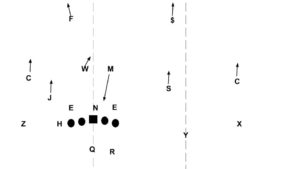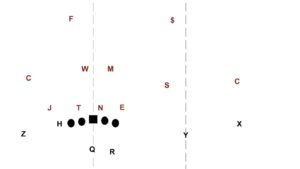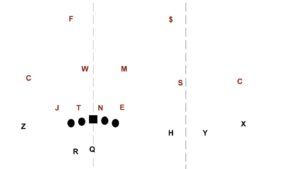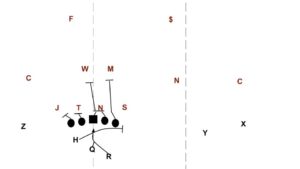So word on the street is that Oklahoma is looking to play more four-down fronts next season and also that Caleb Kelly is likely to maintain his job as a starting outside LB opposite Obo Okoronkwo.
It seems from Bobby’s comments on the matter that he feels that four-down allows Oklahoma a better shot at creating a consistent pass-rush than playing three-down. As a general rule I don’t think this is really accurate. The 3-4 defense is excellent for generating pressure for the obvious reason that the offense has a more difficult time determining who they are going to have to block before the snap. Instead they have to diagnose more after the snap.
Lots of teams these days are enjoying the 3-4’s ability to bring interior pressure as part of a four-man pressure while dropping both OLBs and taking away the seams:

That’s a really useful card to play against spread offenses because it handles some of the spread’s strengths while attacking its weaknesses. The OLBs are generally well positioned to help bracket the slot receivers, whom spread offenses love to target, and if the blitzing inside-backer is good then you can get the kind of quick inside pressure that often spells doom for a passing attack.
The Giants beat the Patriots in the Super Bowl twice because Justin Tuck had two sacks in each game (and a forced safety in the second game) blitzing from an inside alignment. You know what’s easier to find than a 6-5, 265 pound freak that can rush the passer from the edge or inside? A LB that’s good at the insert blitz drawn above.
But the Oklahoma Sooners don’t even know who their inside-backers will be next year. They are returning only one proven pass-rusher from 2016 in Obo Okoronkwo and their next most promising guy in that role is fellow OLB Caleb Kelly.
The unspoken issue is that Oklahoma keeps losing out on top DT targets in recruiting and teams have been recruiting against them by telling players that they don’t want to go eat blocks in Norman when they can attack the backfield somewhere else. Stoops is hardly likely to mention that angle as his primary rationale here but I’m sure it’s a significant factor as well.
Anyways, Oklahoma’s challenge in 2017 is how to get the most out of a pair of excellent OLBs in their pass-rush. The most obvious path is to use Caleb Kelly in the “Roy-backer” role that we should probably rename after Eric Striker in light of the skill sets involved here.

Caleb Kelly is at the “sam” linebacker position and can work off the edge or play underneath in coverage as needed, Okoronkwo is still at his “jack” linebacker position and he’s on the edge where he can rush from a stand-up position or still drop into coverage to maintain some disguise in the scheme.
But there are some problems with having Caleb Kelly lined up out wide on that slot receiver…
The trips problem
Playing the 6-3, 221 pound Caleb Kelly out wide over the slot receiver is a questionable tactic in the Big 12 regardless of the trips problem. Spread offenses love to use the slot to attack teams and even with Steven Parker at the strong safety spot behind him, this is an exposed alignment for a guy who was recruited to rush the passer.
But the trips problem seriously exacerbates the issues, as you can see from this view:

As a sam linebacker here Kelly is lined up pretty far wide to effectively blitz the edge and if you move him closer to threaten a blitz you give away your coverage call (that safety and mike linebacker are going to have to play man coverage on the two slot receivers).
Even if you limit the occasions that he blitzes this formation, which is conceding a lot, he’s still a major liability in coverage because you don’t want to have to lean on any coverage call that asks him to carry a slot receiver on a vertical route. The number of possible coverages and blitzes that the OC and QB have to worry about becomes minimal in a hurry and then they start targeting your weak spots with ruthless precision.
So in essence, with Kelly as a field outside linebacker opponents can turn to a very common formation to make Oklahoma predictable in the pass-rush and vulnerable in coverage all in one fell swoop. Not a great outcome for a team trying to win in a passing league.
The solution? Two-down.
The 2-4-5 is the way that Oklahoma can get the benefit of having a pair of great outside rushers without getting exposed on the perimeter. It’s a four-down structure but the DE positions are staffed by outside linebackers playing stand-up techniques instead:

Now you have a lot more flexibility out wide with man coverage from the strong safety and nickel over the two slot receivers as a realistic option. Getting man coverage from Steven Parker, Will Johnson, Jordan Thomas, and CB no. 2 (Jordan Parker) and a pass rush that includes both Kelly and Obo is a winning set-up for the Sooners in pass defense.
I can’t even remember a Sooners defense that was that threatening with what they could do in a base four-man pressure. They probably haven’t had something that potent since Venables left.
But what about the run defense?
The question with the 2-4-5 is whether you want to make it your solution to all spread sets or if you want to use it when offenses take the TE out of the game and bring in a fourth WR. Against a TE, perhaps aligned as an H-back, then the 2-4-5 has to deal with issues such as this one:

On this popular “split zone” concept Kelly would have to deal with a kick out block from an H-back from across the formation. On a “counter” run it’d be the same story but now Kelly would be contending with a guard. Obo would have to deal with all of the same issues, of course, and at 6-2, 240 he’s not exactly a big thundering threat against the run either.
It’s possible to handle these concepts from a 2-4 if your outside LB/DE guys are good against the run, Wisconsin did this last year quite effectively but they had Vince Biegel (6-3, 246, about to be drafted) and T.J. Watt (6-4, 252, about to be drafted) both of whom were big, powerful, and well trained in this style.
The Big 12 isn’t as physical or big on the edges as the Big 10 but it could still be a challenge for Obo and Kelly, particularly in year one in the scheme. So the Sooners may choose to handle TE sets with the 4-3 illustrated above. However, they’d still be vulnerable to a pulling guard kicking out Kelly from a four-receiver set and they’d still vulnerable to a compromising trips formation when three WRs are on the field with a TE.
In Mike Stoops first season at Oklahoma he had Corey Nelson on the team yet chose to emphasize pass defense over run defense and rolled with a nickel/dime defense that regularly featured the Sooners in a 4-1-6 package against teams that played with four receivers. The result was that the Sooners were murder against the pass but were gashed by the run trying to play with a 5-man box.
Since then the Sooners have often trended in the other direction, sacrificing passing defense for run defense. Caleb Kelly’s potential as a playmaker is going to force them to make a tough decision again about whether they’d like to try and mitigate some personnel issues against the run or against the pass. It’ll be interesting to see what Big Game Bob and cautious Mike determine is best.

None of these strategies would slow down Kevin Sumlin’s Black Attack offense.
Watching OU’s defense since Mike returned from the desert there has been a definite regression and I never understood their switch to the 3-3-5.
Understand the logic on a chalk board, but it never seemed like a very good fit, the defensive line played tentative, and they were undisciplined. How many times did a Texas running back break a long run because a Sooner defender literally ran themselves out of a play and left a gaping hole.
Is it possible that the move to four defensive linemen is a step to going back to a simpler system that allows the players to be more aggressive and attack versus what we have seen in the past seasons?
I think that and the recruiting angle are the major keys. You surrender your advantage of being Oklahoma and being able to recruit DL that can disrupt the offense at the point of attack and you waste/fail to engage the guys you do get like Charles Walker.
Davey, I’ll also be interested in seeing whether this reduces their problem in switching out personnel. They seemed to burn a lot of timeouts and/or get substitution penalties these past couple of years.
Since Mike has come back there just seem to be this slow erosion of what at one time was a very confident and aggressive side of the ball for OU.
You make a great point that at times last year it seemed to be a contast between TCU and OU’s defensive staffs as to which could seem to be the most out of whack in regards to subbing in players and getting calls in from the sidelines.
Both units the last few years have been plagued with assignment busts, players at times seeming to go where they want, and a basic break down in some fundamentals. Two units that were once very good tackling groups seemed to struggle in that basic area of defense.
Understand where part of that uncertainty came from the TCU staff with the number of inexperienced coaches, but that is not the case with the OU staff. Cooks, Kish, Thibodeaux, and Stoopes have multiple years and the unit looked completely unprepared at multiple times.
I think it’s at least possible that the players see Mike Stoops’ presence as pure nepotism and unmerited, preventing them from buying in more fully.
The other part to playing the 2-4-5 is feeling comfortable with your interior defensive linemen to take on double-teams. And not simply for 60 snaps or so, but for 80-90 in the Big 12. The alignment of the outside backers gives them a great edge rush position, but it also more easily allows offensive linemen to pound the interior guys and work up the linebackers. Something the Stoops’ will have to consider in making their decision.
Well it can work like an Over or Under front so long as their isn’t a TE on the line, that’s the only time where you have to really worry about double teams.
But in the B12 would you rather be worried about being big enough up front or being sound enough in coverage?
1) Or if they have an H-back. Offensive line doesn’t want to run split zone in the diagram above. They want to run inside zone wit the H-back kicking out the same side OLB to get two double-teams in the interior.
2) Depends on the team I’m facing. E.g., Texas and K-State scare me more on the ground than the air, so I’d take my chances with subpar coverage.
A stand-up DE isn’t going to get doubled by an H-back even though he has to worry about the kick out blocks. I know a TE or H-back can allow you to create a double team on a DT but that’s true regardless of whether you’re using an OLB or a true DE in a four-down front.
Split zone is nice in the diagram above if you like your tackle to reach that LB and you like the matchup between your H-back and that OLB. That was my point there, is the concern that Kelly isn’t good at the POA on stuff like that (or the kick out you mention).
Easier to game plan specifically outside of your normal deal for KSU (which you’re probably doing anyways) and Texas then against everyone else, right?
1) Yes, you can run that blocking scheme regardless of whether there’s a DE or OLB to the H-back side. Its just a lot easier for the H-back when the guy is standing up and lined up about a foot further out from the tackle.
(OLB has to line up a little wider if standing up to prevent the tackle from getting directly underneath him at the snap since he’s standing. OLB still engages the tackle, but has to do it from a different angle since he’s not down low.)
2) Oh, I’d definitely worry more about being sound in coverage against teams like OSU, Texas Tech, Baylor, TCU, and WVU. No argument there.
But there’s still Ohio State on the schedule. And I’m not so sure about my answer for that one.
I’d try a 3-4 against the run heavy teams, perhaps even when they go 3-wide, with 2-4-5 as a similarly ripped defense for the passing teams. That’s what I’d expect from them next season although perhaps Mike will instead stay in a 3-4 and cheat the safeties or something.
Right. Maybe go 3-4 vs. two back / RB & H-back offenses, and 2-4-5 vs. one back ones.
The trick is what you do against teams that go 20 personnel and have stud slot WRs.
I think I’d go 2-4 and just try to really drill Kelly in DE techniques. Maybe drop a safety down to help out as well.
Ian, I have often postulated that Patterson, in his heart of hearts, would love nothing more than to line up with one NT and ten safeties.
Call it the Angry Birds defense.
I really like that Philly, mind if I use it?
Ian:
Replay fail to yours.
Feel free to use that, I borrow stuff from you all the time.
Big schematic questions for the Big 12: Defense – Concerning Sports
[…] I’ve gone over this quite a bit already. If the Sooners are going to play Caleb Kelly out wide instead of using a nickel that raises big questions about how they’ll play coverage in such a way as to avoid getting shredded by a spread passing attack. It also raises the question of where Kelly fits if the Sooners do get into a nickel package? […]
OU’s 2017 D: Systemic failure or temporary setback? – Concerning Sports
[…] had the primary question confront OU in 2017 as how they were going to utilize 5-star LB Caleb Kelly in a way that would work against the explosi…. While athletic, Kelly isn’t a DB in terms of his coverage skill set and I had major […]
How the Grinch can steal a defense – Concerning Sports
[…] also inherits “the Caleb Kelly problem” which is having a big, talented linebacker who doesn’t know how to play inside and has […]